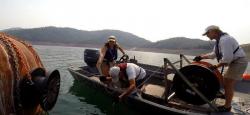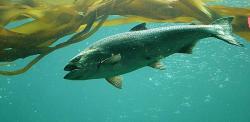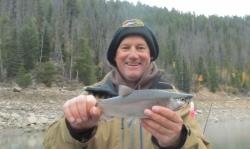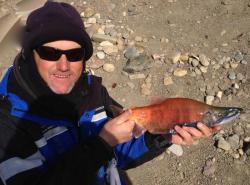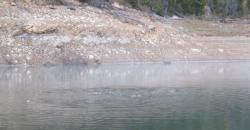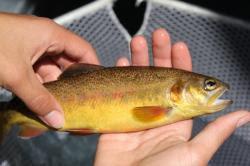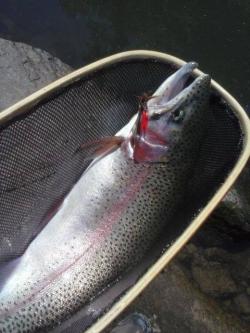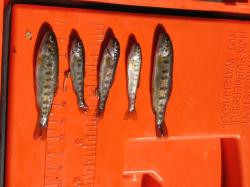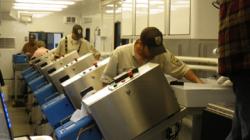Wisconsin DNR sets open house events and tours at egg collection facilities in Racine, Kewaunee, Sturgeon Bay. You can tour a Wisconsin salmon hatchery.
from The Fishing Wire
MADISON — Up and down the Wisconsin shores of Lake Michigan, chinook salmon are staging for the biggest race of their lives – a final run to spawn in rivers including the Root in Racine, Kewaunee in Kewaunee County and Strawberry Creek in Door County.
Workers at DNR’s Strawberry Creek Chinook Facility outside Sturgeon Bay crowd salmon in a pen before spawning.WDNR Photo
When the time is right – likely starting in the next week or so – Wisconsin Department of Natural Resources staff will be there waiting to collect eggs and milt used in producing the next generation of fish for Lake Michigan stocking.
Visitors will be able to see the action firsthand at open house events at the C.D. “Buzz” Besadny Anadromous Fish Facility on Saturday, Oct. 3 and Root River Steelhead Facility on Saturday, Oct. 10. At the Strawberry Creek facility, another key source for chinook salmon eggs, visitors are welcome during daylight hours.
“What started in the 1960s as an effort to control alewife populations by stocking Pacific salmon has turned into a sport fishery that generates some $4 billion per year for the economy of the Great Lakes region,” said Justine Hasz, DNR fisheries bureau director. “Each year the fall spawning runs are a reminder of how our stocking efforts contribute to this economic impact by creating recreational opportunities for anglers of all ages. We look forward to welcoming visitors to our open houses where they can learn more about our fisheries management and propagation efforts.”
The open house events at Besadny and Root River feature egg collection demonstrations as well as fly casting and tying lessons, youth instruction and opportunities to learn Lake Michigan fishing tips from expert anglers. The Besadny open house features an opportunity to sponsor tagged fingerling sturgeon and participate in the river release of these young fish.
Mike Baumgartner, who supervises the Besadny facility in Kewaunee, said based on reports of salmon staging near the mouth of the river, he expects a strong run of fish again this year.
“Visitors can expect great viewing along the banks of the river, a fish-eye perspective through the underwater windows and a look at egg collection through a window in the processing area,” Baumgartner said. “We’ll also offer guided tours of the facility, fish print t-shirt making and fishing lessons along with other activities. Visitors can park in a lot down the road and walk or take the horse and wagon ride to get here. It should be a great day.”
The open house events are free and open to the public with food and beverages available from local groups as well as guided facility tours and activities geared to youth. Trails and paths near the facilities offer opportunities for families to explore the river environment and enjoy wildlife and bird viewing.
The Oct. 3 event at the Besadny facility in Kewaunee runs from 9 a.m. to 3 p.m. The facility, on the Kewaunee River, was built in 1989-1990 and collects eggs from chinook and coho salmon as well as brown and steelhead or rainbow trout for rearing in a series of ponds. A processing building featuring a lobby with displays and a public viewing window was completed in 1996.
The Oct. 10 event at the Root River facility in Racine also runs from 9 a.m. to 3 p.m. The facility was built in 1993-1994 along the Root River by DNR in partnership with the Salmon Unlimited fishing club. It serves as a significant source of coho salmon, steelhead and brown trout eggs and plays an important role in the collection of biological data relating to overall fish health, growth rates, migration patterns and other data. In addition, DNR crews collect seeforellen brown trout from the river in November to ensure the ability to stock this important strain in the future.
Fisheries staff members anticipate processing fish at the third egg collection facility, the Strawberry Creek Chinook Facility outside Sturgeon Bay, on Oct. 5, 8, 12, 15 and 19.
The fall egg collection marks the start of DNR’s propagation process. The eggs will be hatched and raised at DNR facilities until they are ready for stocking at about four months for chinook and at one and a half years for coho, steelhead and brown trout. The different species are stocked according to the stage in their lifecycle at which naturally reproducing fish would normally leave the tributaries to live in Lake Michigan. That stage is much earlier for chinook.
To learn more, visit dnr.wi.gov and search “fisheries open house.”
FOR MORE INFORMATION CONTACT: Mike Baumgartner, C.D. “Buzz” Besadny Anadromous Fish Facility supervisor, michael.baumgartner@wisconsin.gov, 920-388-1025; John Komassa, DNR southeast hatchery group section chief, john.komassa@wisconsin.gov, 608-275-3315; Brad Eggold, DNR Lake Michigan fisheries supervisor, Bradley.Eggold@wisconsin.gov, 414-382-7921; Bob Fahey, DNR fisheries operations supervisor, Root River, 608-275-3251, robert.fahey@wisconsin.gov; Jennifer Sereno, DNR communications, jennifer.sereno@wisconsin.gov, 608-770-8084.


